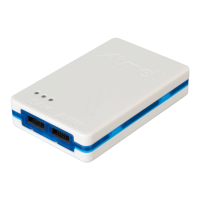4.3.6. Special Considerations
JTAG interface
On some Atmel AVR UC3 devices the JTAG port is not enabled by default. When using these devices it is
essential to connect the RESET line so that the Atmel-ICE can enable the JTAG interface.
aWire interface
The baud rate of aWire communications depends upon the frequency of the system clock, since data
must be synchronized between these two domains. The Atmel-ICE will automatically detect that the
system clock has been lowered, and re-calibrate its baud rate accordingly. The automatic calibration only
works down to a system clock frequency of 8kHz. Switching to a lower system clock during a debug
session may cause contact with the target to be lost.
If required, the aWire baud rate can be restricted by setting the aWire clock parameter. Automatic
detection will still work, but a ceiling value will be imposed on the results.
Any stabilizing capacitor connected to the RESET pin must be disconnected when using aWire since it
will interfere with correct operation of the interface. A weak external pullup (10kΩ or higher) on this line is
recommended.
Shutdown sleep mode
Some AVR UC3 devices have an internal regulator that can be used in 3.3V supply mode with 1.8V
regulated I/O lines. This means that the internal regulator powers both the core and most of the I/O. Only
Atmel AVR ONE! debugger supports debugging while using sleep modes where this regulator is shut off.
4.3.7. EVTI / EVTO Usage
The EVTI and EVTO pins are not accessible on the Atmel-ICE. However, they can still be used in
conjunction with other external equipment.
EVTI can be used for the following purposes:
• The target can be forced to stop execution in response to an external event. If the Event In Control
(EIC) bits in the DC register are written to 0b01, high-to-low transition on the EVTI pin will generate
a breakpoint condition. EVTI must remain low for one CPU clock cycle to guarantee that a
breakpoint is triggered. The External Breakpoint bit (EXB) in DS is set when this occurs.
• Generating trace synchronization messages. Not used by the Atmel-ICE.
EVTO can be used for the following purposes:
• Indicating that the CPU has entered debug mode. Setting the EOS bits in DC to 0b01 causes the
EVTO pin to be pulled low for one CPU clock cycle when the target device enters debug mode.
This signal can be used as a trigger source for an external oscilloscope.
• Indicating that the CPU has reached a breakpoint or watchpoint. By setting the EOC bit in a
corresponding Breakpoint/Watchpoint Control Register, the breakpoint or watchpoint status is
indicated on the EVTO pin. The EOS bits in DC must be set to 0xb10 to enable this feature. The
EVTO pin can then be connected to an external oscilloscope in order to examine watchpoint timing.
• Generating trace timing signals. Not used by the Atmel-ICE.
4.4. tinyAVR, megaAVR, and XMEGA Devices
AVR devices feature various programming and debugging interfaces. Check the device datasheet for
supported interfaces of that device.
Atmel Atmel-ICE [USER GUIDE]
Atmel-42330C-Atmel-ICE_User Guide-10/2016
35

